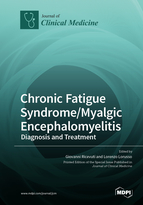Chronic Fatigue Syndrome/Myalgic Encephalomyelitis: Diagnosis and Treatment
A special issue of Journal of Clinical Medicine (ISSN 2077-0383).
Deadline for manuscript submissions: closed (15 September 2021) | Viewed by 104674
Special Issue Editors
2. Internal Medicine, Saint Camillus International Medical University, Rome, Italy
Interests: aging; Alzheimer’s disease; pharmacology; genetics; neuroscience; biomedical science; inflammation; immunology; diagnosis; neutrophils; pathogenesis; phagocytes; chemotaxis; oxidative stress
Interests: multiple sclerosis; neurological paraneoplastic syndromes; brain tumours; motor neuron disorder; fatigue; brain function localization; cinema and art in neuroscience
Special Issue Information
Dear Colleagues,
Background and History of this Topic
Chronic fatigue syndrome, or myalgic encephalomyelitis (ME/CFS), or fibromyalgia, is a debilitating disease, with unknown causes. From the perspectives on the etiology and pathophysiology, CFS has been labeled differently, which influenced changes in case definitions and terminologies, like fibromyalgia, myalgic encephalomyelitis or chronic fatigue syndrome. Normally, we are used to identifying this disease as CFS, or chronic fatigue syndrome.
CFS or fibromyalgia is characterized by chronic and diffuse musculoskeletal pain, often associated with asthenia, sleep disorders, cognitive problems (e.g. attention, memory), psychological problems (e.g. anxiety, depression) and a wide range of somatic and neurovegetative symptoms.
The most appropriate therapeutic approach is multidisciplinary, based on an individualized program of care that includes different types of interventions: educational, pharmacological and non-pharmacological.
Aim and Scope of the Special Issue
The current concept is that CFS pathogenesis is a multifactorial condition. Various studies have sought evidence for a disturbance in immunity in people with CFS. An alteration in cytokine profile, a decreased function of natural killer (NK) cells, a presence of autoantibodies and a reduced responses of T cells to mitogens and other specific antigens have been reported. The observed high level of pro-inflammatory cytokines may explain some of the manifestations, such as fatigue and flulike symptoms, and influence NK activity. Abnormal activation of the T lymphocyte subsets and a decrease in antibody-dependent cell-mediated cytotoxicity have been described. An increased number of CD8+ cytotoxic T lymphocytes and CD38 and HLA-DR activation markers have been reported, and a decrease in CD11b expression associated with an increased expression of CD28+ T subsets has been observed. This Special Issue aims to discuss the immunological aspects of CFS and explore the various pathogenic hypothesis, as well as offering information about the recent knowledge on effective pharmacological, non-pharmacological, integrative, physical and psychological therapeutic approaches.
Cutting-Edge Research
The cutting-edge research defines and discovers causes better, by suggesting a molecular diagnosis, and a cure for CFS. This is of interest for clinicians and researchers, health psychologists, and those who explore the mind–body connection through behavioral medicine and psychoneuroimmunology.
For these reasons, the welfare treatment of CFS is required, and we need to report, in our Special Issue:
- a customized multidisciplinary approach;
- conventional and unconventional pharmacological treatments;
- a definition of individual assistance paths, starting from path diagnostic-therapeutic assistance (PDTA) specific, in which there are identified competences, territorial references and diagnostic and therapeutic procedures for patients, who take into account all factors affecting health, well-being and illness, including the psychological dimensions and lifestyle of a person.
What Kind of Papers We Are Soliciting
We solicited papers addressing CFS, fibromialgia, fatigue, topics described and identified above, clinical, laboratory, therapeutic and research items, and related issues, in a creative and novel way. In addition, we solicited “Patients’ Associations and Groups” to publish their own reports on different national and international experiences. Research papers, clinical reports, trials reports, experimental treatment reports, laboratory investigation, reviews and new perspectives will also be accepted.
Prof. Giovanni Ricevuti
Dr. Lorenzo Lorusso
Guest Editors
Manuscript Submission Information
Manuscripts should be submitted online at www.mdpi.com by registering and logging in to this website. Once you are registered, click here to go to the submission form. Manuscripts can be submitted until the deadline. All submissions that pass pre-check are peer-reviewed. Accepted papers will be published continuously in the journal (as soon as accepted) and will be listed together on the special issue website. Research articles, review articles as well as short communications are invited. For planned papers, a title and short abstract (about 100 words) can be sent to the Editorial Office for announcement on this website.
Submitted manuscripts should not have been published previously, nor be under consideration for publication elsewhere (except conference proceedings papers). All manuscripts are thoroughly refereed through a single-blind peer-review process. A guide for authors and other relevant information for submission of manuscripts is available on the Instructions for Authors page. Journal of Clinical Medicine is an international peer-reviewed open access semimonthly journal published by MDPI.
Please visit the Instructions for Authors page before submitting a manuscript. The Article Processing Charge (APC) for publication in this open access journal is 2600 CHF (Swiss Francs). Submitted papers should be well formatted and use good English. Authors may use MDPI's English editing service prior to publication or during author revisions.
Keywords
- Anxiety disorders
- Autoimmunity
- Biomarkers
- Chronic fatigue syndrome
- Clinical laboratories test
- Diagnostic criteria
- Immunology
- Myalgic encephalomyelitis
- Oxygen ozone therapy
- Personalized medicine







